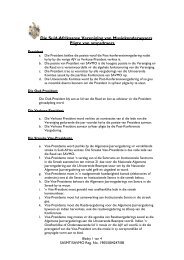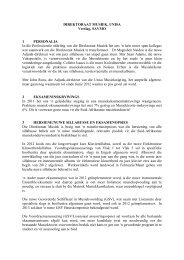2006 Edition 2 (Issue 144) - Sasmt-savmo.org.za
2006 Edition 2 (Issue 144) - Sasmt-savmo.org.za
2006 Edition 2 (Issue 144) - Sasmt-savmo.org.za
You also want an ePaper? Increase the reach of your titles
YUMPU automatically turns print PDFs into web optimized ePapers that Google loves.
someone who wants to change their technique. Many<br />
people think they can’t learn to play the guitar because<br />
they have small hands. Alexander Technique definitely<br />
helps here, but so does using correct basic principles regarding<br />
posture and holding the guitar correctly.<br />
The book is definitely not suitable for beginners. The<br />
music notation is far too advanced, and includes no explanation<br />
of basic concepts of notation or note reading<br />
at all — even on the ‘easy pages’. It does not progress in<br />
a logical fashion, but jumps randomly between topics<br />
that are simple to understand and others that are highly<br />
technical, with fairly advanced rhythms, tuning methods<br />
etc. (Not everyone has a tuning fork on hand, or<br />
understands the physics of sound.) For beginners especially,<br />
the Alexander Technique ideas would need to be<br />
presented in conjunction with suitable music. The presentation<br />
of scales is very confusing for someone who is<br />
doing music for the first time. What is a scale? What is<br />
a fret? Arpeggios within the octave and dominant seventh<br />
arpeggios!? I don’t really agree with Mr. Inglis that<br />
almost everyone has a basic concept of Western major<br />
scales! Some of the teaching ideas in the book are<br />
very strange and confused. The author assumes a good<br />
It is not too often that you<br />
find an instruction book in<br />
which the author has really<br />
managed to envelop<br />
the spirit of its intent. Seymour<br />
Bernstein’s With Your<br />
Own Two Hands is such a<br />
book. This internationally<br />
known pianist, teacher, and composer guides the modern<br />
pianist out of a wealth of experience to the heart of<br />
music and music making. As the subtitle declares, the<br />
reader is directed towards self-discovery through music.<br />
In the preface the author expresses the wish that<br />
every musician must acknowledge that “I am what my<br />
talent is.” Most importantly, the author urges musicians<br />
to be contributors — not only of artistic values, but of<br />
human values as well. The book is therefore in many<br />
ways an endeavour to help both the amateur and the<br />
professional to merge the personal and musical self and<br />
as a result realise his or her full potential. He writes in<br />
an informal style and the many narrative accounts on<br />
a personal level make the book even more accessible.<br />
His commitment to a life in music is inspirational and<br />
should motivate students and professional musicians to<br />
journey with perseverance and enjoyment.<br />
In the first of three parts, Bernstein confronts the<br />
most fundamental problems every student of music<br />
must deal with at some time or another. His advice on<br />
knowledge of music by the reader, and then explains a<br />
very elementary musical idea in the next sentence. One<br />
would need to buy a basic rudiments of guitar music<br />
book to get anywhere with it, and have lessons with an<br />
Alexander teacher. (Not very appealing for the regular<br />
teacher to lose his pupils to an AT specialist unless the<br />
teacher is willing to spend time learning this approach.<br />
Most teachers are too busy to start again and are set in<br />
their ways in any case!) Perhaps workshops could be run<br />
to introduce the concept to teachers.<br />
The book seems a bit gimmicky to me with all the<br />
dance pictures — rather over the top and irritating to<br />
be honest. The pictures showing hand positions were<br />
mostly with the guitar lying flat!! — not a good subliminal<br />
image for a new guitarist! The book has possibly not<br />
been edited yet, since it is full of errors.<br />
Jenny Bonsignore (a professional member of the SASMT) has<br />
been teaching music for 25 years, including piano, recorder and<br />
voice. For the past 14 years she has taught class music with guitar<br />
as one of the instruments: “…folk and classical at a very elementary<br />
level. Most learners have never held a guitar before — I teach<br />
them to hold it correctly.”<br />
Bernstein, S. 1981. With your own Two Hands: Self-discovery through Music.<br />
New York: Schirmer. ISBN 0-7935-5712-7. Distributed by Hal Leonard.<br />
www.halleonard.com.<br />
Waldo Weyer<br />
the issues involved in practising is offered with great<br />
candour. Students and teachers alike will find the five<br />
profiles on the different kinds of pupils and their habits<br />
of practising enlightening. Flowing from this, Bernstein<br />
discusses issues concerning the relationship between<br />
teacher and pupil with penetrating discernment. The<br />
art of practising is also looked upon from the all important<br />
perspective of concentration. A vast array of ideas<br />
is given to assist a musician in the quest for a sincere<br />
involvement with music. Bernstein concludes this first<br />
part with an insightful section on feeling. His explanation<br />
of physical adaptability to sound is compulsory<br />
reading for any instrumentalist.<br />
The second part stresses with wonderful simplicity<br />
some of the key factors that will assure musical playing<br />
and physical comfort at the piano. The disciplines<br />
covered in these chapters include: tempo, rhythm, and<br />
pulse, the importance of listening, as well as a variety<br />
of technical problems, including the relaxation myth.<br />
It is, however, the final section of this part, concerning<br />
choreography, which I found most applicable to my<br />
own teaching and playing. The chosen examples from<br />
the music literature are most apt. Even more so are the<br />
articulate descriptions of the variety of movements that<br />
are needed to convert the symbols of musical notation<br />
into physical actions (or muscular responses) and that<br />
will ultimately result in a musical and expressive rendering<br />
of the composition.<br />
Suid-Afrikaanse Musiek Onderwyser |<strong>144</strong> | November <strong>2006</strong>




